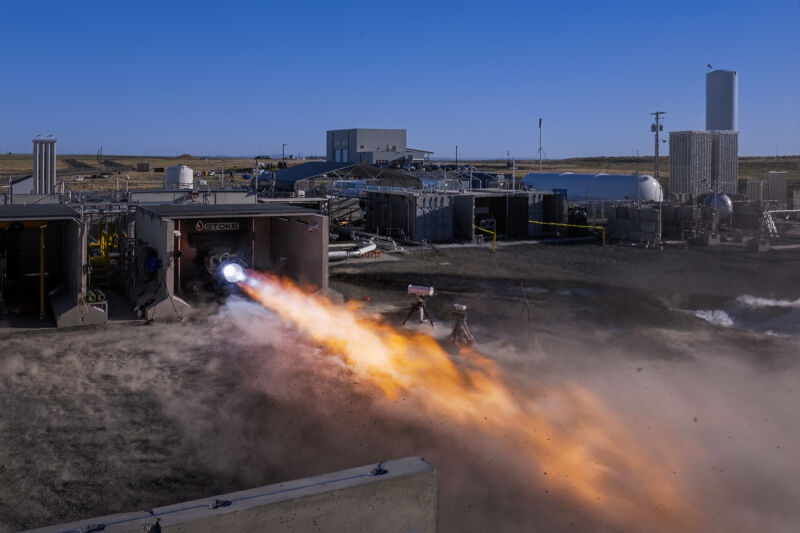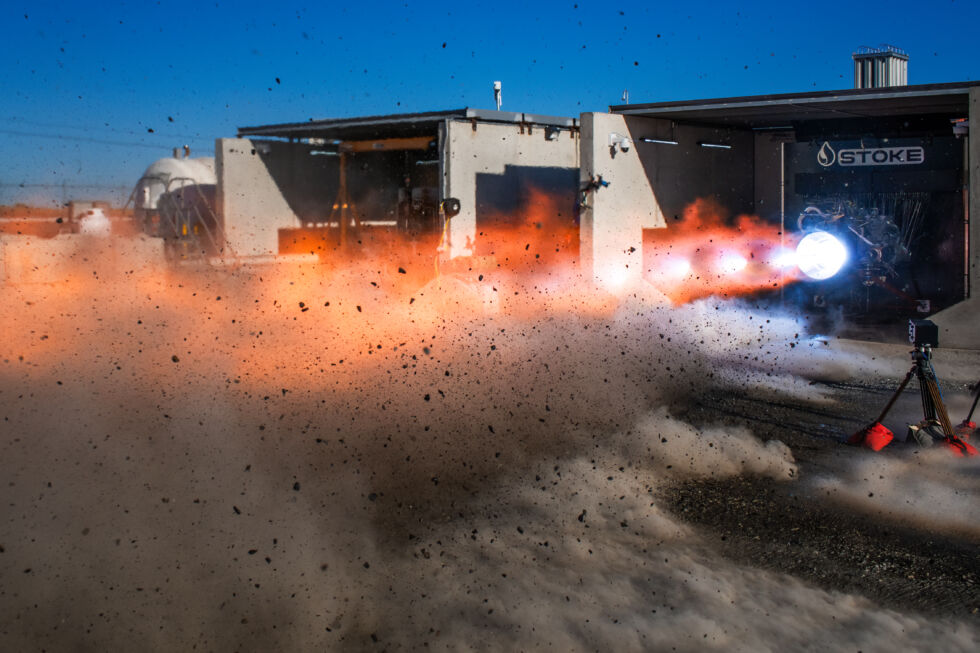Get stoked! —
“This industry is going toward full reusability. To me, that is the inevitable end state.”

Enlarge / A drone camera captures the hotfire test of Stoke Space’s full-flow staged combustion engine at the company’s testing facility in early June.
Stoke Space
On Tuesday, Stoke Space announced the firing of its first stage rocket engine for the first time earlier this month, briefly igniting it for about two seconds. The company declared the June 5 test a success because the engine performed nominally and will be fired up again soon.
“Data point one is that the engine is still there,” said Andy Lapsa, chief executive of the Washington-based launch company, in an interview with Ars.
The test took place at the company’s facilities in Moses Lake, Washington. Seven of these methane-fueled engines, each intended to have a thrust of 100,000 pounds of force, will power the company’s Nova rocket. This launch vehicle will have a lift capacity of about 5 metric tons to orbit. Lapsa declined to declare a target launch date, but based on historical developmental programs, if Stoke continues to move fast, it could fly Nova for the first time in 2026.
Big ambitions for a small company
Although it remains relatively new in the field of emerging launch companies, Stoke has gathered a lot of attention because of its bold ambitions. The company intends for the two-stage Nova rocket to be fully reusable, with both stages returning to Earth. To achieve a vertical landing, the second stage has a novel design. This oxygen-hydrogen engine is based on a ring of 30 thrusters and a regeneratively cooled heat shield.
Lapsa and Stoke, which now has 125 employees, have also gone for an ambitious design in the first-stage engine tested earlier this month. The engine, with a placeholder name of S1E, is based on full-flow, stage-combustion technology in which the liquid propellants are burned in the engine’s pre-burners. Because of this, they arrive in the engine’s combustion chamber in fully gaseous form, leading to a more efficient mixing.
Such an engine—this technology has only previously been demonstrated in flight by SpaceX’s Raptor engine, on the Starship rocket—is more efficient and should theoretically extend turbine life. But it is also technically demanding to develop, and among the most complex engine designs for a rocket company to begin with. This is not rocket science. It’s exceptionally hard rocket science.
It may seem like Stoke is biting off a lot more than it can chew with Nova’s design. Getting to space is difficult enough for a launch startup, but this company is seeking to build a fully reusable rocket with a brand new second stage design and a first stage engine based on full-flow, staged combustion. I asked Lapsa if he was nuts for taking all of this on.
Are these guys nuts?
“I’ve been around long enough to know that any rocket development program is hard, even if you make it as simple as possible,” he responded. “But this industry is going toward full reusability. To me, that is the inevitable end state. When you start with that north star, any other direction you take is a diversion. If you start designing anything else, it’s not something where you can back into full reusability at any point. It means you’ll have to stop and start over to climb the mountain.”
This may sound like happy talk, but Stoke appears to be delivering on its ambitions. Last September, the company completed a successful “hop” test of its second stage at Moses Lake. This validated its design, thrust vector control, and avionics.

Enlarge / This engine is designed to power the Nova rocket.
Stoke Space
After this test, the company turned its focus to developing the S1E engine and put it on the test stand for the first time in April before the first test firing in June. Going from zero to 350,000 horsepower in half a second for the first time had a “pretty high pucker factor,” Lapsa said of the first fully integrated engine test.
Now that this initial test is complete, Stoke will spend the rest of the year maturing the design of the engine, conducting longer test firings, and starting to develop flight stages. After that will come stage tests before the complete Nova vehicle is assembled. At the same time, Stoke is also working with the US Space Force on the regulatory process of refurbishing and modernizing Launch Complex 14 at Cape Canaveral Space Force Station in Florida.